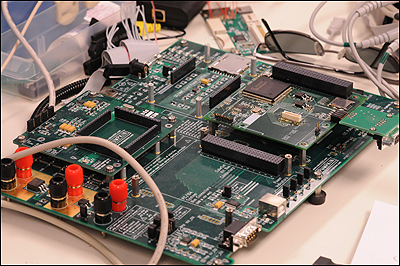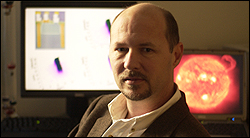Smaller, lighter electronic components are more vulnerable to pesky cosmic ray particles
Vanderbilt researchers are launching a miniature satellite into space in a quest to help future space missions better combat the harsh conditions of space, particularly radiation that can cause glitches or breakdowns in electronic components.

Funded by NASA and the Department of Defense, this multi-mission, radiation effects test bed payload will be among the first of its kind in the United States. Two launches currently are scheduled – one in the summer of 2013 and one in the winter of 2013. More launches are expected in 2014.
The Vanderbilt payloads will integrate with two spacecrafts being built by a Saint Louis University team. They are also planning to fly a payload on a spacecraft designed in collaboration with the Radio Amateur Satellite Corporation (AMSAT).
They are using a CubeSat, a small, square satellite, only 10 cm – or four inches – on a side. Several CubeSats can be stuck together, as they will be in this case, making this a two-unit CubeSat.
CubeSats are launched as secondary payloads on rockets that are primarily intended to launch other larger spacecraft. When the rocket reaches a certain pre-determined location, it sends a signal and the CubeSats are launched on their separate missions. They are, so to speak, diminuitive cosmic hitchhikers.

Launching CubeSat missions is not new. What’s new is that Vanderbilt researchers can focus on both education and actual hands-on testing of electronic radiation effects with this mission.
The launches provide an unprecedented opportunity to test the billions of calculations Vanderbilt researchers have conducted on the ground using computers. But more than that, this project exposes a new generation to the potentially exciting discoveries where electrical engineering and computer science intersect with space exploration.
Undergraduates and graduate students will work with Vanderbilt’s Institute for Space and Defense Electronics (ISDE) engineers to design and build the payload. Researchers also are reaching out to high school and middle schools in Tennessee to involve them in the project and engage a younger generation in engineering, space exploration and electronics.
The team, led by Vanderbilt professors Robert Reed and Robert Weller, will begin by selecting teachers and classes with whom to work. One plan calls for the younger students to actually man ground stations where they can log in and collect scientific data beamed from the spacecraft. A web cam set up in the development lab will showcase for the students how their data is analyzed.

“We can build a CubeSat payload in less than a year and for just about the cost of testing the parts on the ground. The overall goal is to validate our computer simulations, which is impossible to do using conventional radiation sources,” said Weller, a professor of electrical engineering.
The experiments are important because electronic devices operating in the harsh environment of space are constantly bombarded with radiation, which can cause certain parts to fail or behave in unexpected ways. Engineers are finding that some devices are failing more often as nanotechnology has enabled devices to be made with smaller and smaller components. While the smaller components make them lighter and faster, they also make them more susceptible to random radiation events. It’s important to be able to predict when, why, and how components of a spacecraft might fail so that engineers can fix or override potential problems.
“In space, devices are subjected to bombardment by cosmic rays, elements varying from hydrogen to iron and beyond, coming from all directions at the same time,” explained Reed, professor of electrical engineering. Experiments on the ground use atom smashers, but those produce only one type of radiation in one pencil beam, allowing researchers to physically test only one condition at a time.

This type of radiation-effects research is equally important for devices on the ground. While the earth’s magnetic field and atmosphere generally protects people from exposure to too much radiation from space, a few cosmic rays get through, and these can affect ordinary devices like computers and cell phones. The cosmic rays interact with air molecules and produce daughter particles like neutrons and muons, a kind of heavy electron that lives only about two millionths of a second.
Up until now, because transistors have been large, muons have not been able to deposit enough energy to have an impact on electronic devices. However, today’s parts are smaller and require less power, so they are more vulnerable.
What might that mean to regular people? Researchers are predicting far more occurrences of “the blue screen of death,” that awful moment when your computer dies and you’re confronted with just a swirling icon. If those potential failures can be predicted by experiments on the ground and in space, electrical engineers can work to fix them.
“It’s important to understand how these components function in space. We need to know the failure modes and frequency of occurrence so designers can design around them,” Reed explained.
Recently, the government has been retrofitting systems to launch these education-oriented, cost-efficient CubeSats. “Because of this emerging interest in small spacecraft, there are a lot of good opportunities for us to get rides to space,” Reed said.
The project is funded through a grant from NASA’s Experimental Program to Stimulate Competitive Research (EPSCoR) and through two grants funded by the Defense Threat Reduction Agency’s Basic Research Program.